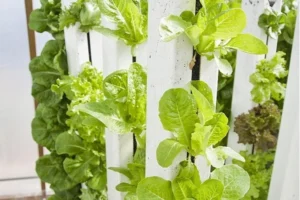Upcycling is all about giving new life to things that would otherwise end up in the trash. It’s a creative and sustainable way to reduce waste and make the most of what you already have. Hydroponics, on the other hand, is a method of growing plants without soil, using nutrient-rich water. The best part? It works great in small spaces, especially with vertical gardening systems. People are becoming more interested in sustainable living, and vertical gardens are a perfect solution. You can grow your own food indoors, even in limited space. In this article, we’ll show you how to turn everyday household items into an eco-friendly hydroponic garden. It’s a fun way to create a space-saving system that lets you grow fresh herbs and vegetables all year.
Why Upcycle Household Items?
Upcycling isn’t just about being creative; it’s a practical way to live more sustainably. By reusing everyday items, you reduce the demand for new products and minimize the waste that ends up in landfills. It’s a small but powerful step toward living with less impact on the environment. When you choose to repurpose things like plastic bottles, jars, or old containers, you’re not only cutting down on waste but also giving those items a new purpose. This process conserves resources that would otherwise be used to manufacture new products. Additionally, upcycling saves money. Instead of spending on gardening supplies or expensive systems, you can use materials you already own. It’s an easy way to build a greener, more self-sufficient lifestyle while keeping costs low. Ultimately, it’s about finding value in what you already have, rather than consuming more.
Choosing the Right Household Items for Hydroponics
When setting up your hydroponic garden, you’ll be surprised at how many household items you can repurpose. Common items like plastic bottles, old jars, and even used containers can serve as excellent plant holders. PVC pipes can be transformed into vertical systems, saving space while still offering enough room for plant growth. Here’s a list of some great materials to consider:
- Plastic Bottles: Cut them in half to create small planters, or use them as hydroponic channels.
- Old Jars or Glass Containers: Perfect for growing smaller plants like herbs.
- Milk Cartons: A great option for larger, deep-rooting plants.
- PVC Pipes: Ideal for vertical setups and creating a gravity-fed water system.
- Egg Cartons: A creative way to start seedlings before transferring to larger systems.
When choosing items, make sure they’re durable, can hold water, and are large enough to support healthy plant growth. Look for materials that won’t crack or break over time, ensuring your system lasts.
Step-by-Step Guide to Upcycling for Hydroponics
Step 1: Gather Your Materials
Before you start, gather all the items you’ll need. Look around your home for materials like plastic bottles, old jars, milk cartons, or cardboard boxes. You’ll also want a few tools to help with cutting and modifying these items. A sharp pair of scissors or a utility knife works well for cutting plastic. A drill with a small bit is useful for creating drainage holes. You’ll need string, zip ties, or small hooks to hang your system if you plan to go vertical. For more advanced setups, you might consider a small water pump to circulate the nutrient solution. Don’t forget a tray to catch any excess water, and some gravel or hydroponic growing medium like clay pellets to support the plants.
Step 2: Set Up the Hydroponic System
Now it’s time to plan your layout. If you’re going vertical, consider stacking plastic bottles or old milk cartons. For example, you can stack several bottles in a pyramid shape, creating space for each plant to grow. Alternatively, use a hanging system—suspend jars or smaller containers from a wooden frame or ceiling hooks. PVC pipes can also be mounted on a wall to make a space-efficient vertical garden. This arrangement allows the water to flow down from the top, ensuring each plant gets its share of nutrients. A sturdy setup is key to ensuring stability, so test it to make sure everything is secure and balanced.
Step 3: Create Plant Holders/Containers
Next, modify your materials for planting. For plastic bottles, you’ll want to cut the top off to create a larger opening, leaving enough space for the roots to spread out. Drill a few small holes in the bottom to ensure proper drainage, as plants don’t like sitting in stagnant water. For jars, you can simply poke holes in the lids to fit plant seedlings, allowing them to grow through. If you’re using PVC pipes, drill holes along the length of the pipe for the plants to fit in. You can even create small cups inside the pipes using plastic cups or net pots to hold the plants. Make sure the size of the containers matches the plants you intend to grow, as larger plants may need more space.
Step 4: Install the Hydroponic System
Once your containers are ready, it’s time to set up the water and nutrient solution. Fill the containers with the water and mix in your hydroponic nutrients. If you’re using a pump, set it up to circulate the water from one container to the next, ensuring an even distribution of nutrients. For simpler systems, you can manually water each container with a watering can, but using a pump ensures a consistent flow. You’ll want to check that each container has access to the water and nutrients without overflowing. Adding a tray underneath each container can catch any excess water. Keep the water level stable and adjust the flow as needed to prevent plants from drying out or drowning.
Step 5: Choosing Plants for Hydroponics
Now for the fun part—choosing your plants! Hydroponic systems are perfect for growing herbs and leafy greens. Basil, mint, parsley, and cilantro thrive in small spaces and require minimal maintenance. Lettuce, spinach, arugula, and kale are also great choices, as they have shallow root systems and grow quickly. If you have a bit more space, try adding tomatoes, strawberries, or peppers, which can grow well in larger containers or vertical systems. Start by selecting varieties that suit your system’s size. For instance, smaller, compact plants like basil and lettuce do well in plastic bottles or jars. If you’re growing more substantial plants like tomatoes, opt for larger containers or PVC pipe systems that can support deeper roots. Keep in mind the light and temperature requirements of your plants as well—some may need more sunlight than others.
Maintaining Your Upcycled Household Items
Maintaining your upcycled household items is essential to keep your hydroponic system in top shape. Regular cleaning is the first step. Rinse out your containers and wipe down the surfaces to prevent algae buildup or any mold from growing. You’ll also want to remove any plant debris or old roots from your system. Make sure your upcycled items, like plastic bottles or jars, stay free from any gunk that could block the flow of water or nutrients.
Check for leaks or cracks in your materials, especially in areas that might have been modified, like holes drilled into containers. A small leak can lead to water loss, making your system less efficient. If you find any, patch them up with waterproof tape or sealant.
Also, remember to top up your nutrient solution regularly. Over time, plants absorb the nutrients, and the water can lose its effectiveness. If your plants start looking yellow or weak, it may be a sign that the nutrient balance is off. You might need to add more nutrients or adjust the strength of your solution.
Water stagnation can also be a problem if your containers aren’t draining properly. If you notice stagnant water, check that the water is circulating correctly, especially if you’re using bottles or jars that might get clogged. Ensure that your system has good drainage and that water is flowing freely to avoid root rot. Additionally, keep an eye on your pH levels. The ideal range for most hydroponic plants is between 5.5 and 6.5, so test it regularly. By staying on top of these small tasks, your upcycled system will run smoothly, and your plants will continue to thrive.
Creative Ideas for Upcycled Hydroponic Systems
There are so many creative ways to build your hydroponic system using upcycled items. For example, you can repurpose wine bottles as vertical planters. Just drill holes along the bottles, fill them with a growing medium, and hang them on a wooden frame. Milk cartons are another great choice. Cut them open to create shallow planting trays or turn them into small vertical planters for herbs and greens.
Old drawers can be transformed into unique hydroponic containers too. Just line the bottom with a waterproof material and add plants. You could even stack several drawers to create a vertical garden. For a decorative touch, consider painting your upcycled items in bright, fun colors or adding some decorative stones around the base of the plants. Adding string lights around your system can also give it a cozy, inviting feel while adding visual interest to your space.
Conclusion
Upcycling for hydroponics offers many benefits. It’s an eco-friendly way to reuse household items, reduce waste, and create a sustainable growing system. By using materials you already have, you save money and create a unique garden right in your own space. Plus, it’s a great way to grow herbs and vegetables without the need for a lot of room.
If you’re new to hydroponics, start small. Experiment with different items, like plastic bottles or jars, to see what works best for you. Don’t be afraid to get creative and have fun with the process.
Now is the perfect time to try upcycling a few household items and build your vertical garden. Start with something simple and watch your plants grow. You’ll be amazed at how easy it is to create a green, sustainable space at home!




